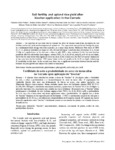Use este identificador para citar ou linkar para este item:
http://www.alice.cnptia.embrapa.br/alice/handle/doc/927375Registro completo de metadados
| Campo DC | Valor | Idioma |
|---|---|---|
| dc.contributor.author | PETTER, F. A. | pt_BR |
| dc.contributor.author | MADARI, B. E. | pt_BR |
| dc.contributor.author | SILVA, M. A. S. da | pt_BR |
| dc.contributor.author | CARNEIRO, M. A. C. | pt_BR |
| dc.contributor.author | CARVALHO, M. T. de M. | pt_BR |
| dc.contributor.author | MARIMON JÚNIOR, B. H. | pt_BR |
| dc.contributor.author | PACHECO, L. P. | pt_BR |
| dc.date.accessioned | 2012-06-29T11:11:11Z | pt_BR |
| dc.date.available | 2012-06-29T11:11:11Z | pt_BR |
| dc.date.created | 2012-06-29 | pt_BR |
| dc.date.issued | 2012 | pt_BR |
| dc.identifier.citation | Pesquisa Agropecuária Brasileira, v. 47, n. 5, p. 699-706, maio 2012. | pt_BR |
| dc.identifier.uri | http://www.alice.cnptia.embrapa.br/alice/handle/doc/927375 | pt_BR |
| dc.description | The objective of this work was to evaluate the effect of biochar made from Eucalyptus on soil fertility, and on the yield and development of upland rice. The experiment was performed during two years in a randomized block design with four replicates, in a sandy loam Dystric Plinthosol. Four doses of NPK 05-25-15, annually distributed in stripes (0, 100, 200 and 300 kg ha-1), and four doses of biochar (0, 8, 16 and 32 Mg ha-1), applied once in the first year - alone or with NPK - were evaluated. In the first year, biochar positively affected soil fertility [total organic carbon (TOC), Ca, P, Al, H+Al, and pH], at 0-10 cm soil depth, and it was the only factor with significant effect on yield. In the second year, the effect of biochar diminished or was overcome by the fertilizer. TOC moved down in the soil profile to the 0-20 cm depth, influencing K availability in this layer. In the second year, there was a significant interaction between biochar and the fertilizer on plant growth and biomass dry matter accumulation. | pt_BR |
| dc.language.iso | eng | eng |
| dc.rights | openAccess | eng |
| dc.subject | Fitomassa | pt_BR |
| dc.title | Soil fertility and upland rice yield after biochar application in the Cerrado. | pt_BR |
| dc.type | Artigo de periódico | pt_BR |
| dc.date.updated | 2012-06-29T11:11:11Z | pt_BR |
| dc.subject.thesagro | Carbono | pt_BR |
| dc.subject.thesagro | Acidez do solo | pt_BR |
| dc.subject.thesagro | Arroz | pt_BR |
| dc.subject.thesagro | Oryza sativa | pt_BR |
| dc.subject.thesagro | Cerrado | pt_BR |
| dc.subject.thesagro | Fertilidade do solo | pt_BR |
| dc.subject.thesagro | Macroelemento | pt_BR |
| dc.subject.nalthesaurus | biochar | pt_BR |
| riaa.ainfo.id | 927375 | pt_BR |
| riaa.ainfo.lastupdate | 2012-06-29 | pt_BR |
| dc.contributor.institution | FABIANO ANDRÉ PETTER, UNIVERSIDADE FEDERAL DO PIAUÍ; BEATA EMOKE MADARI, CNPAF; MELLISSA ANANIAS SOLER DA SILVA, CNPAF; MARCO AURÉLIO CARBONE CARNEIRO, UNIVERSIDADE FEDERAL DE GOIÁS; MARCIA THAIS DE MELO CARVALHO, CNPAF; BEN HUR MARIMON JÚNIOR, UNIVERSIDADE ESTADUAL DE MATO GROSSO; LEANDRO PEREIRA PACHECO, UNIVERSIDADE FEDERAL DE GOIÁS. | pt_BR |
| Aparece nas coleções: | Artigo em periódico indexado (CNPAF)  | |
Arquivos associados a este item:
| Arquivo | Descrição | Tamanho | Formato | |
|---|---|---|---|---|
| a10v47n5.pdf | 409,88 kB | Adobe PDF |  Visualizar/Abrir |









